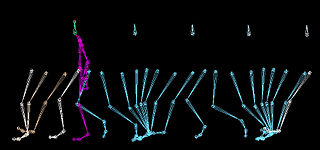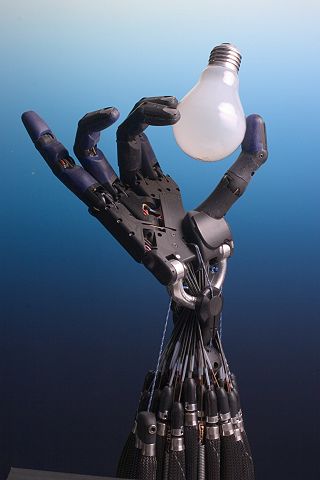Related Research Articles

Walking is one of the main gaits of terrestrial locomotion among legged animals. Walking is typically slower than running and other gaits. Walking is defined by an 'inverted pendulum' gait in which the body vaults over the stiff limb or limbs with each step. This applies regardless of the usable number of limbs—even arthropods, with six, eight, or more limbs, walk.
BEAM robotics is a style of robotics that primarily uses simple analogue circuits, such as comparators, instead of a microprocessor in order to produce an unusually simple design. While not as flexible as microprocessor based robotics, BEAM robotics can be robust and efficient in performing the task for which it was designed.

Rectilinear locomotion or rectilinear progression is a mode of locomotion most often associated with snakes. In particular, it is associated with heavy-bodied species such as terrestrial African adders, pythons and boas; however, most snakes are capable of it. It is one of at least five forms of locomotion used by snakes, the others being lateral undulation, sidewinding, concertina movement, and slide-pushing. Unlike all other modes of snake locomotion, which include the snake bending its body, the snake flexes its body only when turning in rectilinear locomotion.
Robot locomotion is the collective name for the various methods that robots use to transport themselves from place to place.
Passive dynamics refers to the dynamical behavior of actuators, robots, or organisms when not drawing energy from a supply. Depending on the application, considering or altering the passive dynamics of a powered system can have drastic effects on performance, particularly energy economy, stability, and task bandwidth. Devices using no power source are considered "passive", and their behavior is fully described by their passive dynamics.
SIGMO is a humanoid robot designed to demonstrate the applications of passive dynamics technologies.

A mobile robot is an automatic machine that is capable of locomotion. Mobile robotics is usually considered to be a subfield of robotics and information engineering.

A six-legged walking robot should not be confused with a Stewart platform, a kind of parallel manipulator used in robotics applications.
Modular self-reconfiguring robotic systems or self-reconfigurable modular robots are autonomous kinematic machines with variable morphology. Beyond conventional actuation, sensing and control typically found in fixed-morphology robots, self-reconfiguring robots are also able to deliberately change their own shape by rearranging the connectivity of their parts, in order to adapt to new circumstances, perform new tasks, or recover from damage.

Legged robots are a type of mobile robot which use articulated limbs, such as leg mechanisms, to provide locomotion. They are more versatile than wheeled robots and can traverse many different terrains, though these advantages require increased complexity and power consumption. Legged robots often imitate legged animals, such as humans or insects, in an example of biomimicry.

RunBot is a miniature bipedal robot which belongs to the class of limit cycle walkers. Instead of using a central pattern generator it uses reflexes which generate the gait. The reflexes are triggered by ground contact sensors in the feet which then activate the motors. The generation of the walking gait is straightforward: when a foot touches the ground the other leg is lifted upwards so that the robot falls forward. This then causes this leg to touch the ground and so forth. The walking speed can be improved by means of reinforcement learning because there are only a few parameters in this scheme. RunBot was built in 2005 by Tao Geng as part of his PhD under supervision of Prof Woergoetter and after an idea by Dr Porr to use a walking robot to benchmark reflex based reinforcement learning rules. Its movements and adaptability are based on the work of neurophysiologist Nikolai Bernstein.
Neurorobotics is the combined study of neuroscience, robotics, and artificial intelligence. It is the science and technology of embodied autonomous neural systems. Neural systems include brain-inspired algorithms, computational models of biological neural networks and actual biological systems. Such neural systems can be embodied in machines with mechanic or any other forms of physical actuation. This includes robots, prosthetic or wearable systems but also, at smaller scale, micro-machines and, at the larger scales, furniture and infrastructures.

RHex is an autonomous robot design, based on hexapod with compliant legs and one actuator per leg. A number of US universities have participated, with funding grants also coming from DARPA.

Robotics is an interdisciplinary branch of Electronics & Communication, computer science and engineering. Robotics involves the design, construction, operation, and use of robots. The goal of robotics is to design machines that can help and assist humans. Robotics integrates fields of mechanical engineering, electrical engineering, information engineering, mechatronics engineering, electronics, biomedical engineering, computer engineering, control systems engineering, software engineering, mathematics, etc.

Undulatory locomotion is the type of motion characterized by wave-like movement patterns that act to propel an animal forward. Examples of this type of gait include crawling in snakes, or swimming in the lamprey. Although this is typically the type of gait utilized by limbless animals, some creatures with limbs, such as the salamander, forgo use of their legs in certain environments and exhibit undulatory locomotion. In robotics this movement strategy is studied in order to create novel robotic devices capable of traversing a variety of environments.
The following outline is provided as an overview of and topical guide to robotics:

LAURON is a six-legged walking robot, which is being developed at the FZI Forschungszentrum Informatik in Germany. The mechanics and the movements of the robot are biologically-inspired, mimicking the stick insect Carausius Morosus. The development of the LAURON walking robot started with basic research in field of six-legged locomotion in the early 1990s and led to the first robot, called LAURON. In the year 1994, this robot was presented to public at the CeBIT in Hanover. This first LAURON generation was, in contrast to the current generation, controlled by an artificial neural network, hence the robot's German name: LAUfROboter Neuronal gesteuert. The current generation LARUON V was finished in 2013.

Bio-inspired robotic locomotion is a fairly new subcategory of bio-inspired design. It is about learning concepts from nature and applying them to the design of real-world engineered systems. More specifically, this field is about making robots that are inspired by biological systems, including Biomimicry. Biomimicry is copying from nature while bio-inspired design is learning from nature and making a mechanism that is simpler and more effective than the system observed in nature. Biomimicry has led to the development of a different branch of robotics called soft robotics. The biological systems have been optimized for specific tasks according to their habitat. However, they are multifunctional and are not designed for only one specific functionality. Bio-inspired robotics is about studying biological systems, and looking for the mechanisms that may solve a problem in the engineering field. The designer should then try to simplify and enhance that mechanism for the specific task of interest. Bio-inspired roboticists are usually interested in biosensors, bioactuators, or biomaterials. Most of the robots have some type of locomotion system. Thus, in this article different modes of animal locomotion and few examples of the corresponding bio-inspired robots are introduced.

Arm swing in human bipedal walking is a natural motion wherein each arm swings with the motion of the opposing leg. Swinging arms in an opposing direction with respect to the lower limb reduces the angular momentum of the body, balancing the rotational motion produced during walking. Although such pendulum-like motion of arms is not essential for walking, recent studies point that arm swing improves the stability and energy efficiency in human locomotion. Those positive effects of arm swing have been utilized in sports, especially in racewalking and sprinting.

Auke Jan Ijspeert is a Swiss-Dutch roboticist and neuroscientist. He is a professor of biorobotics in the Institute of Bioengineering at EPFL, École Polytechnique Fédérale de Lausanne, and the head of the Biorobotics Laboratory at the School of Engineering.
References
- ↑ Brosl Hasslacher and Mark W. Tilden (1995). "Living machines". Robotics and Autonomous Systems. Elsevier BV. 15 (1–2): 143–169. doi:10.1016/0921-8890(95)00019-c.
- ↑ Adam Harris and James M. Conrad (2010). Hybrid control of a simple walking autonomous robot. Proceedings of the IEEE SoutheastCon 2010 (SoutheastCon). IEEE. doi:10.1109/secon.2010.5453839.
- ↑ Moses, Matthew S (2000). A Minimalist Approach to Design of Walking Robots (Technical report). Sandia National Labs., Albuquerque, NM (US); Sandia National Labs.
- ↑ Wu, Dongrui and Tan, Woei Wan and Vadakkepat, Prahlad (2005). "A Comparison of Several Hardware-Realized Central Pattern Generators (CPGs)". Advanced Control Technology Laboratory, National University of Singapore.
{{cite journal}}: CS1 maint: multiple names: authors list (link)